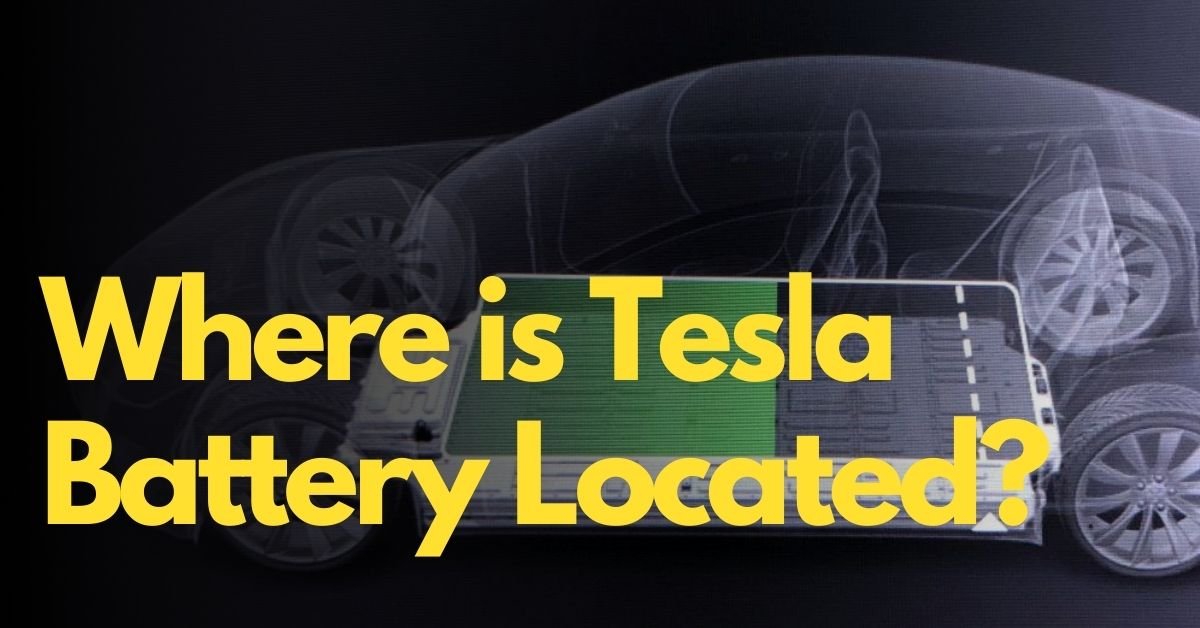How Many Solar Panels To Charge A Tesla? (2023 Guidelines)
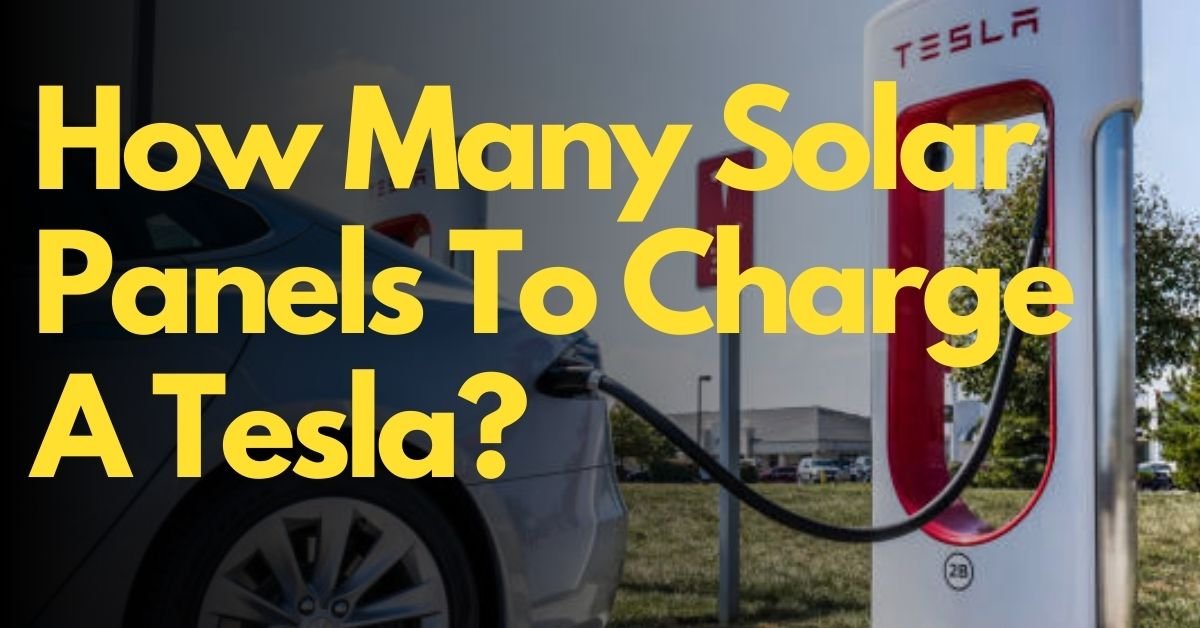
Have you ever wondered how many solar panels to charge a Tesla? Going green and using solar panels to power your Tesla Model can be an excellent choice for both your wallet and the environment. In this guide, we’ll break down how many solar panels it takes to charge a Tesla, making the process easy to understand.
Whether you’re new to solar power or just curious about the panels you need to charge your Tesla, we’ve got you covered. Let’s dive into the world of sustainable energy and find out how to charge your Tesla with solar panels!”
Tesla Design Parameters
When Tesla makes their electric cars, they pay attention to some important things. These things are called “design parameters.” They help Tesla build cars that work well and meet people’s needs.
State of Charge
“State of Charge” is like looking at how full your Tesla’s battery is. It’s like checking if your phone’s battery is half full or almost empty. Tesla cars have a big battery inside, and the state of charge tells you how much energy is left in that battery.
Battery Capacity
Imagine the battery in your Tesla is like a big container of energy. “Battery capacity” tells us how much energy that container can hold. Some Teslas have bigger containers (batteries) than others. A bigger container can hold more energy and let your car drive farther on a single charge.
Target Tesla Energy Requirement
This is like saying, How much energy does a Tesla car need to run well? Tesla figures out how much energy their cars need to drive nicely and make you happy. They set a goal for this, and it helps them design the battery and other parts of the car.
So, in simple words, Tesla’s design parameters are like rules they follow to make sure their cars have enough energy (battery capacity) and to check how full the battery is (state of charge) so that the car works well and meets your needs. They also have a target for how much energy the car should use to drive nicely (target Tesla energy requirement).
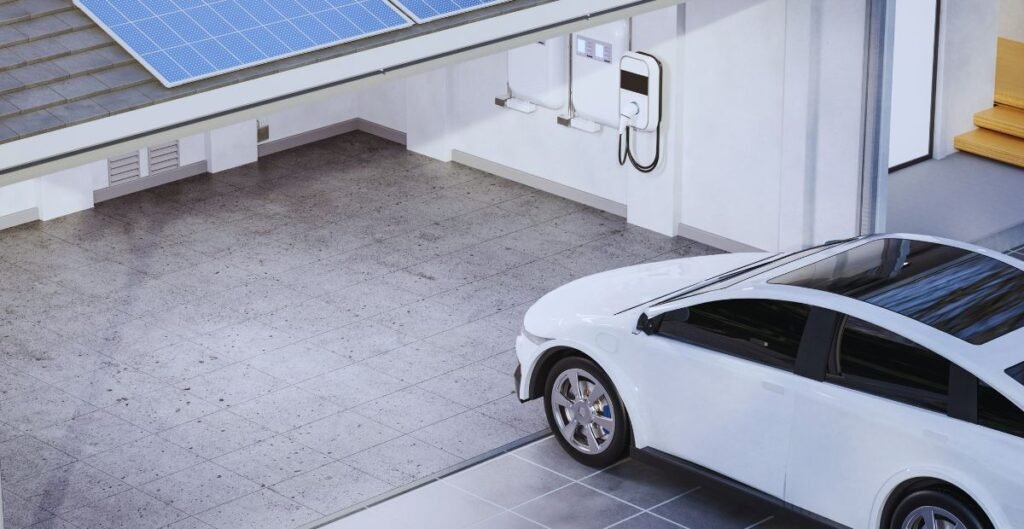
Solar Panel Design Overview
Solar panels are devices designed to convert sunlight into electricity. They are made up of many smaller units called solar cells. These cells work together to capture sunlight and turn it into usable power. Solar panels are usually installed on rooftops or in open areas where they can get a lot of sunlight.
Solar Panel Overview:
A solar panel, also known as a solar module, is a flat, rectangular device that looks like a big shiny tile. It’s made of special materials that can capture sunlight and create electricity. When sunlight hits the solar panel, it starts producing power, which can be used to run appliances in your home or charge batteries, like the ones in electric cars.
Solar Panel Rating:
Solar panels are rated based on how much electricity they can produce under specific conditions. This rating is called the “wattage” or “watt rating.” Common ratings for residential solar panels range from 250 to 400 watts. A higher watt rating means the panel can produce more electricity when it gets plenty of sunlight.
Solar Panel Efficiency:
Efficiency tells us how good a solar panel is at turning sunlight into electricity. The efficiency of most solar panels is around 15% to 20%. This means that only 15% to 20% of the sunlight they receive is converted into usable electricity. Higher-efficiency panels are better at this conversion, but they can be more expensive.
Inherent Inefficiencies:
Solar panels have some natural limitations that make them less efficient. For example, they work best when the sun is directly shining on them, so they produce less power on cloudy or rainy days. They also lose some energy as heat during the conversion process.
Environmental Inefficiencies:
Solar panels are generally good for the environment because they produce clean electricity without pollution. However, making solar panels does require energy and materials, which can have environmental impacts. Manufacturers are working to reduce these impacts through recycling and using more eco-friendly materials.
Solar Inverter Inefficiency:
Solar inverters are devices that convert the direct current (DC) electricity produced by solar panels into the alternating current (AC) electricity used in homes. Inverters can have some inefficiencies, meaning they don’t turn all the DC power into AC power perfectly. Most inverters are around 90-95% efficient, so a small amount of electricity can be lost during this conversion.
In simple terms, solar panels are like magic sunlight catchers that turn sunshine into electricity. They have ratings that show how much power they can make, but they’re not 100% efficient because of natural and environmental factors.
Also, the device that changes the electricity they make isn’t perfect, so a tiny bit can be lost. Overall, though, solar panels are a great way to use the sun’s energy and help the environment.
How Many Solar Panels Charge a Tesla?
The number of solar panels required to charge a Tesla depends on several factors, including the model of the Tesla, the capacity of the solar panels, the location and amount of sunlight available, and the efficiency of the solar panel system. I can provide a general estimate based on some typical numbers, but keep in mind that actual requirements may vary.
- Tesla Model: The energy capacity of Tesla cars varies depending on the model. For example, a Tesla Model 3 Standard Range has a smaller battery capacity compared to a Tesla Model S Long Range.
- Solar Panel Efficiency: Solar panels come in various efficiency ratings. A typical residential solar panel might have an efficiency of around 15-20%.
- Sunlight Availability: The amount of sunlight your location receives is a crucial factor. Locations with more sunlight will generate more electricity from solar panels.
- Daily Driving Distance: Your daily driving habits also play a role in determining how many panels you need. If you drive long distances every day, you’ll need more solar panels to charge your Tesla.
- Battery Capacity: The capacity of your Tesla’s battery will determine how much energy you need to replenish. For example, if your Tesla has a 75 kWh battery, you’ll need to generate at least 75 kWh of electricity to fully charge it.
- Charging Efficiency: There will be some losses in the charging process due to efficiency, so you may need to generate more electricity than the rated capacity of your Tesla’s battery.
- Storage: If you want to charge your Tesla overnight or during cloudy days, you may need to consider energy storage solutions like a home battery (e.g., Tesla Powerwall).
As a very rough estimate, a typical 250-watt solar panel might generate around 1 kWh of electricity per day in optimal conditions. So, if your Tesla has a 75 kWh battery and you want to fully charge it using solar panels, you might need around 75 solar panels (assuming ideal conditions and no other factors affecting efficiency).
In reality, you may need more panels to account for less-than-ideal conditions and to generate electricity for other household needs.
It’s important to consult with a solar installation professional who can assess your specific situation, including location, energy usage, and Tesla model, to provide a more accurate estimate of how many solar panels you would need to charge your Tesla. They can also help you design a solar panel system that meets your energy needs and budget.

DIY Solar Tesla Charger
If you want to charge your Tesla using the power of the sun, you can create your own solar charger. This DIY project lets you harness the energy from sunlight to charge your electric car. Here’s a simple guide to help you get started.
What You’ll Need:
- Solar Panels: You’ll need solar panels to capture sunlight and turn it into electricity. You can buy these panels from a store or online.
- Inverter: An inverter is a device that changes the electricity generated by the solar panels into a form that your Tesla can use.
- Mounting Hardware: You’ll need equipment to secure the solar panels to your roof or a stand so they can face the sun.
- Wiring: Wiring will connect the solar panels to the inverter and then to your Tesla’s charging station.
- Tesla Charger: Make sure you have a Tesla charging station or connector that matches your car.
Steps to Build Your DIY Solar Tesla Charger:
- Location: Find a suitable location for your solar panels. They should be in a spot that gets a lot of sunlight throughout the day. The roof of your house or a ground-mounted system in your yard are common choices.
- Mount Solar Panels: Use the mounting hardware to secure the solar panels in place. Make sure they face the sun to capture the most sunlight.
- Install Inverter: Connect the inverter to your solar panels. The inverter will convert the electricity from DC (direct current) to AC (alternating current), which your Tesla can use.
- Connect to Charger: Run wires from the inverter to your Tesla charger. Ensure the wiring is done safely and according to local electrical codes.
- Test and Monitor: Once everything is connected, test the system to make sure it’s working. Check your Tesla’s screen to see if it’s charging. You can also install a monitoring system to keep an eye on how much electricity you’re generating.
- Maintenance: Regularly clean your solar panels to keep them working efficiently. Also, check the wiring and connections for any issues.
Benefits of a DIY Solar Tesla Charger:
- Save Money: Charging with solar power can reduce your electricity bills and the cost of fuel for your Tesla.
- Environmentally Friendly: Solar energy is clean and renewable, so using it to charge your Tesla reduces your carbon footprint.
- Energy Independence: Generate your own electricity, reducing your reliance on the grid.
- Long-Term Savings: While setting up a solar charger can be an initial investment, it can pay off in the long run as you save on electricity and fuel costs.
Remember, this project may require some DIY skills and electrical knowledge. If you’re not comfortable with the installation, it’s best to consult a professional to ensure your safety and the efficiency of your solar Tesla charger. Enjoy driving your Tesla powered by the sun!
How can I charge my Tesla with solar panels? Use this calculator to find the right amount
If you own a Tesla and want to use clean, renewable energy to charge it, you can do that with the help of solar panels. Solar panels are like special devices that turn sunlight into electricity.
Here’s a simple guide on how to do it, and we’ll also show you a handy calculator to figure out how many solar panels you might need.
Step 1: Install Solar Panels
First, you need to get solar panels installed on your roof or in your yard. These panels soak up sunlight and convert it into electricity. You’ll need to contact a solar panel installation company to help with this. They will set up the panels for you.
Step 2: Connect to Your Home
The electricity generated by your solar panels can be used to power your home and, of course, charge your Tesla. When the panels make more electricity than your home needs, the extra energy can go to your Tesla.
Step 3: Charging Your Tesla
To charge your Tesla with solar power, you’ll need a special device called an electric vehicle (EV) charger. This charger connects to your Tesla and your solar panel system. You can plug in your Tesla, and it will start charging using the electricity made by your solar panels.
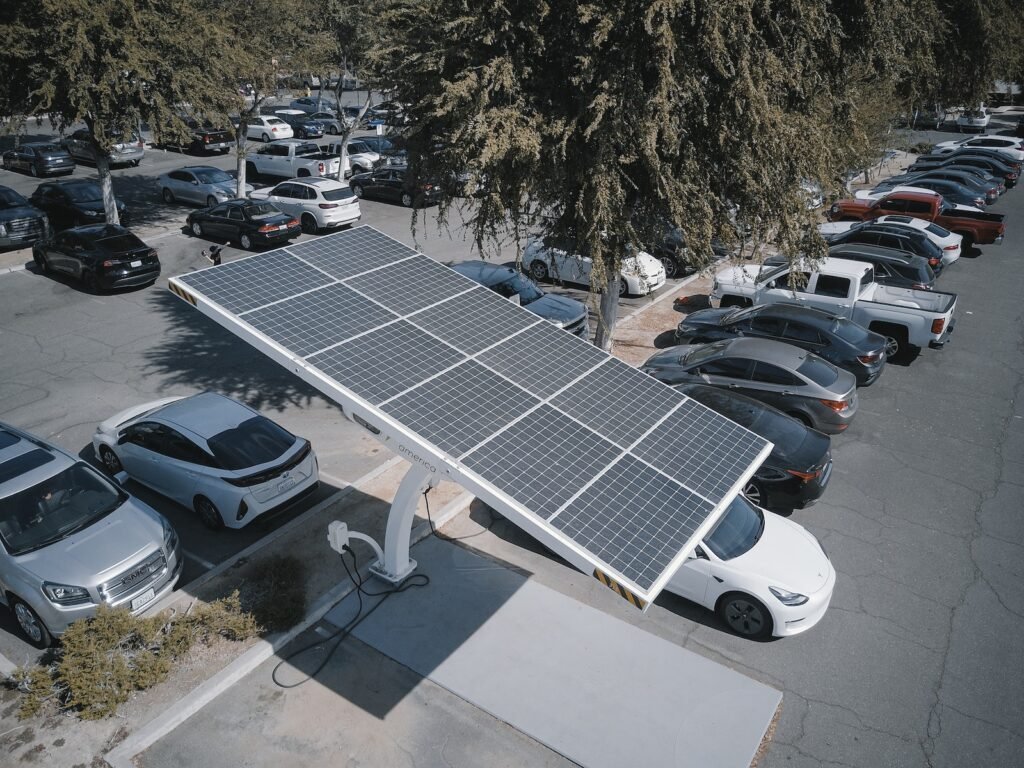
Use the Solar Panel Calculator
Now, to find out how many solar panels you might need to charge your Tesla, you can use a calculator. This calculator will consider things like the size of your Tesla’s battery, how much you drive, and how sunny your location is.
Here’s how you can use it:
- Select Your Tesla Model: Choose your Tesla model from the list. Different Tesla models have different battery sizes.
- Input Daily Driving Distance: Tell the calculator how far you drive in a day. This helps figure out how much energy you need to charge your Tesla.
- Enter Your Location: Type in where you live. Some places get more sunlight than others, so this matters.
- Calculate: Click the “Calculate” button, and the calculator will give you an estimate of how many solar panels you might need.
Remember, this is just an estimate. The actual number of solar panels you need might be more or less depending on many factors. It’s always a good idea to talk to a solar panel expert to get an accurate plan for your unique situation.
In the end, using solar panels to charge your Tesla is a great way to save money on electricity bills and help the environment by using clean energy. Plus, it’s pretty cool to power your electric car with sunshine!
Portable Solar Charger for Electric Cars
A Portable Solar Charger for Electric Cars is like a little power station that you can carry around and use to charge your electric car using sunlight. Here’s some simple information about it:
How It Works:
This portable charger has special solar panels on it. When you place it in the sun, these panels soak up the sunlight and turn it into electricity. This electricity can be used to charge your electric car’s battery.
Easy to Move Around:
One great thing about this charger is that you can take it with you wherever you go. It’s not stuck in one place like the big solar panels on rooftops. So, if you’re on a road trip or camping, you can bring it along to keep your electric car charged.
Helps the Environment:
Using a portable solar charger for your electric car is good for the environment. It doesn’t produce any pollution because it uses clean energy from the sun. This helps reduce the greenhouse gases that harm our planet.
Convenient and Cost-Effective:
It’s convenient because you can charge your car without needing to find a charging station. Plus, it can save you money in the long run since you won’t have to pay for electricity when you’re using sunlight instead.
Useful During Emergencies:
In case of emergencies or power outages, this portable charger can come in handy. You can use it to power up your car and even other devices like phones or camping equipment.
Keep in Mind: While portable solar chargers are helpful, they might not fully charge your electric car quickly. It depends on how much sunlight they get and the size of your car’s battery. So, it’s good for maintaining your car’s charge or giving it a little boost.
In simple terms, a portable solar charger for electric cars is like having a small sun-powered generator that you can carry around to charge your car, save money, and help protect the environment. It’s a handy tool for electric car owners who want to make the most of sunny days.
Solar panels for plug-in hybrids
Solar panels can help power plug-in hybrid cars. These cars can run on electricity and gas. Solar panels are like big, flat, shiny sheets that capture sunlight and turn it into electricity. Here’s how they work with plug-in hybrids:
1. Charging the Car:
- Plug-in hybrid cars have batteries that can be charged with electricity.
- Solar panels can make electricity from sunlight.
- When you park your car, the solar panels on the roof or hood can absorb sunlight and send electricity to the car’s battery.
2. Saving Money:
- Using sunlight to charge your car can save you money on gas and electricity bills.
- It’s like getting free energy from the sun.
3. Environmentally Friendly:
- Solar panels help reduce the need for fossil fuels, which can harm the environment.
- They produce clean energy without pollution.
4. Limited Range:
- Solar panels on a car are usually small, so they can’t fully charge the battery quickly.
- They may add a few extra miles to your car’s range each day.
5. Backup Power:
- Some plug-in hybrids use solar panels to charge a small battery for things like air conditioning or heating when the car is parked.
- This can save energy from the main battery for driving.
6. Not Always Sunny:
- Solar panels work best when it’s sunny.
- On cloudy or rainy days, they won’t generate as much electricity.
In simple terms, solar panels on plug-in hybrid cars are like little power plants on wheels. They help you save money, protect the environment, and give you a bit of extra energy from the sun, but they can’t fully replace traditional charging methods. They are a smart way to make your hybrid car a bit greener and more efficient.
EV charging systems vs. solar panels
Electric vehicles (EVs) are cars that run on electricity instead of gasoline. To make sure they have enough power to drive, they need to be charged, just like how you charge your phone. This is where EV charging systems and solar panels come into play.
EV Charging Systems:
EV charging systems are devices or stations that give electricity to your electric car. You plug your EV into one of these stations, and it fills up your car’s battery with electricity. There are different types of EV chargers:
| Level 1 Charger: | This is like charging your phone with a regular wall socket. It’s slow but can be used at home. |
| Level 2 Charger: | This is faster than Level 1. You might find these in public places, parking lots, or at home with a special setup. |
| DC Fast Charger: | This is the quickest option. You can find them along highways for long trips. |
Solar Panels:
Solar panels are like special devices that capture sunlight and turn it into electricity. Imagine having a magic mat on your roof that soaks up the sun’s rays and turns them into power for your home.
How They Work Together:
Now, let’s see how EV charging systems and solar panels can work together:
- Solar Panels Generate Electricity: During the day, when the sun is shining, solar panels collect sunlight and produce electricity. This electricity can be used to power your home or charge your electric car.
- Charging Your EV with Solar Power: If you have solar panels on your roof, you can connect your EV charger to them. This means you’re using clean, green energy from the sun to charge your car, which is good for the environment.
- Saving Money: Solar panels can also help you save money. When your panels make more electricity than you need, you can send it back to the power company, and they might pay you for it. This extra money can offset your charging costs.
- Environmental Benefits: Using solar power for your EV is eco-friendly. It reduces pollution and greenhouse gases because you’re not using fossil fuels like gasoline.
Tesla Solar Home Charging Station
The Tesla Solar Home Charging Station is a special setup that helps you charge your Tesla electric car using energy from the sun. It’s like having your own mini-power station at home.
Here’s how it works:
- Solar Panels: You have solar panels installed on your roof or in your yard. These panels soak up sunlight and turn it into electricity.
- Electricity Generation: When the sun shines, the solar panels generate electricity. This electricity can be used to power your home, lights, appliances, and, most importantly, charge your Tesla car.
- Charging Your Tesla: You connect your Tesla to a special charger at home. This charger is connected to your solar panels. When you plug in your car, it starts filling up with electricity from the sun.
- Environmentally Friendly: One of the great things about the Tesla Solar Home Charging Station is that it’s good for the environment. Solar energy is clean and doesn’t produce harmful emissions like traditional gasoline cars.
- Cost Savings: By using solar power to charge your Tesla, you can save money on your energy bills. You won’t need to rely as much on electricity from the grid because you’re making your own power.
- Convenience: Having a charging station at home is super convenient. You don’t have to go to a gas station or a public charging station. Your Tesla is always ready to go, fully charged, right in your driveway.
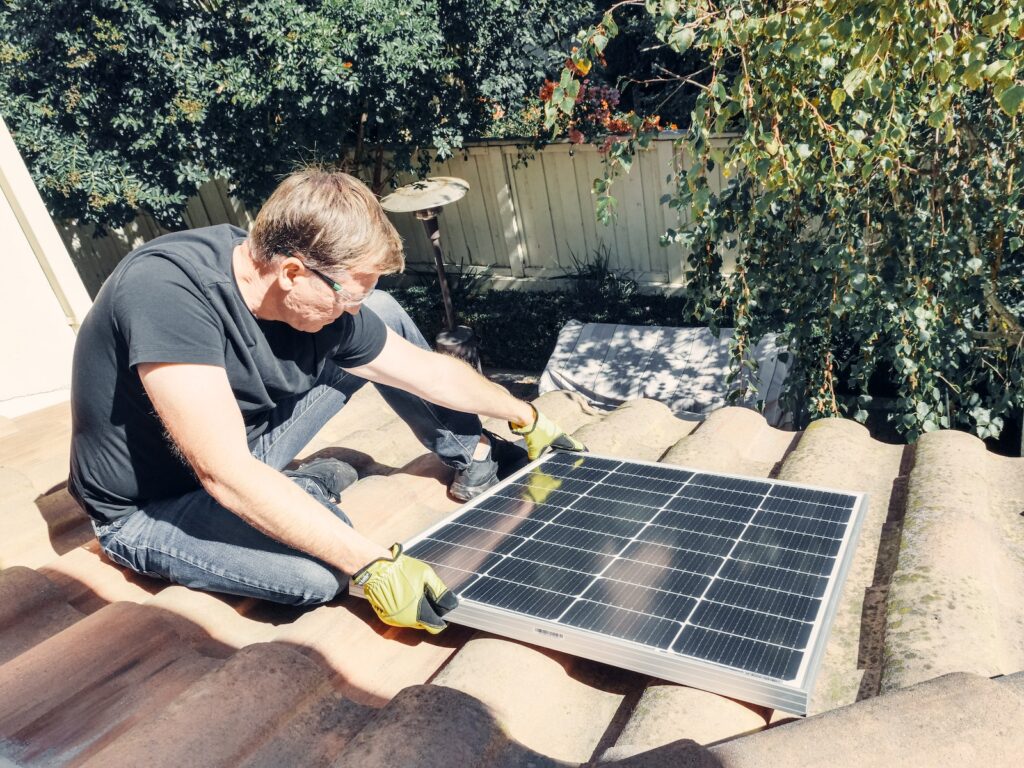
Charging a Tesla Model 3 Solar Panels Vs Grid Electricity
Charging a Tesla Model 3 with solar panels or grid electricity is like choosing between two different ways to give your car energy.
| Using Solar Panels: | Using Grid Electricity: |
|---|---|
| Sun-Powered Energy: Solar panels are like special devices that soak up energy from the sun. They turn sunlight into electricity, which you can use to charge your Tesla. | Convenient: The grid is like a giant power network that delivers electricity to your home. It’s always available, so you can charge your Tesla whenever you want, day or night. |
| Eco-Friendly: When you charge your Tesla with solar panels, you’re using clean, green energy. It doesn’t create pollution or harm the environment. | Costs: You’ll have to pay for the electricity you use from the grid. The cost can vary depending on where you live and how much you use. |
| Savings: Over time, solar panels can save you money because you don’t have to pay for electricity from the grid. The sun’s energy is free! | Reliable: Grid electricity is dependable. It’s there when you need it, so you don’t have to worry about running out of power. |
| Depends on the Sun: Solar panels work best when the sun is shining. So, on cloudy days or at night, you might need a different source of power. |
Which is Better?
The choice between solar panels and grid electricity depends on your preferences and situation:
- If you want to be eco-friendly and save on energy bills, solar panels could be a great choice, but they require an upfront investment.
- If you need a reliable and convenient way to charge your Tesla, grid electricity is the way to go, but it might cost more in the long run.
Some people even use a combination of both, using solar panels when the sun is shining and grid electricity when it’s not. This way, they get the best of both worlds.
Frequently Asked Questions
How many solar panels are needed to fully charge a Tesla?
To charge a Tesla with solar, eight to ten additional solar panels are needed, depending on the model, peak sun hours, and car mileage. The cost is less than driving a gasoline vehicle and even less if using free solar energy. To install solar, visit the Energy Sage Marketplace for multiple quotes.
Can you fully charge a Tesla with solar panels?
Tesla can be charged with solar panels, but a complete solar charging station and an inverter are required. The number of panels depends on the Tesla model, peak sun hours, and average mileage. Charging a Tesla with solar costs less than driving a gasoline vehicle and even less if using free solar energy. The cost varies between $9.62 and $18.30.
How many solar panels are needed to charge an EV?
The number of solar panels needed to charge an electric vehicle (EV) depends on factors like the EV model, peak sun hours, and average mileage. Solar.com recommends five to ten 400-watt panels for an average day of driving.
The exact number depends on solar panel production, EV battery efficiency, and driving habits. For example, a Tesla Model Y Standard Range RWD requires 9.69 kWh of electricity per day.
How many solar panels to charge a Tesla Model 3?
The number of solar panels needed to charge a Tesla daily depends on the model, peak sun hours, and average mileage. For a Tesla Model 3, the smallest 50 kWh battery requires 56 panels for 220 miles.
How many solar panels to charge a Tesla Model Y?
The number of solar panels needed to charge a Tesla Model Y depends on factors like location, driving habits, and battery size. For example, a Model Y with an 80.5 kWh battery requires approximately 3.95 kWp of solar panels in London to charge 3.4 times per month.
For a fully charged Model Y in one day, more panels are needed, with a total of 35.33 kWp needed in London, 21.71 kWp in San Francisco, and 19.9 kWp in Malaga.
How many solar panels to charge a Tesla model?
The number of solar panels needed to charge a Tesla depends on factors like the model, peak sun hours, and average mileage. EnergySage estimates eight to ten additional panels, depending on production, EV battery efficiency, and driving habits. For a 50 kWh Model 3, 56 solar panels are needed.
How many solar panels to charge a Tesla in a day?
The average daily charging of a Tesla EV requires 44-89 solar panels with 300W rated power, depending on factors like panel production, battery efficiency, and driving habits. For a 50 kWh battery, 56 panels are needed.
How long to charge a Tesla with solar panels?
Depending on the Tesla model, sun exposure, energy production, and how much charge the battery needs to reach 100%, charging a Tesla using solar panels can take anywhere from 8 hours to several days. For instance, the ideal charging time for a Tesla Model 3 is 40 hours.
The Tesla Car may be charged in about three to four days of direct sunlight using a 5kW solar panel. However, a 285-rated watt solar panel would require 63 days to fully recharge a Tesla 90 kWh battery.
You would require an array of 75 perfectly efficient PV modules under continuous noon sunlight for 7 hours to fully charge your Tesla battery from 0% to 100% using only portable solar panels
Can you charge a Tesla with portable solar panels?
Yes, you can use portable solar panels to charge a Tesla, but how long it takes and how many panels are needed depends on the Tesla model, the battery capacity, the panel’s efficiency, and the amount of sunlight. A 5kW solar panel may require 20 hours to fully charge a Tesla, compared to 8 to 10 days for a portable solar panel.
However, it is not practicable to use portable solar panels to charge a Tesla due to the fact that electric vehicles consume a lot of energy far more than one portable solar panel can produce in more than 100 days of intense sunlight.
You would need a Tesla charging grid directly connected to the solar panel system’s output connection in order to set up a portable solar panel for charging a Tesla. The portable solar panel’s output of direct current can also be converted to AC power using external power converters.
Can you charge a Tesla with a solar generator?
Tesla can be charged with a solar generator, but the number of panels needed depends on factors like the model, peak sun hours, and average mileage. The maximum solar power output is 10 miles/day, and the internal battery provides only 3 miles of range.
Portable solar panels are possible but not practical due to the time required to charge the battery pack, which could take 10 days or more.
Conclusion
In conclusion, the question of how many solar panels to charge a Tesla is a common one for individuals considering the transition to solar energy for their electric vehicles.
The number of solar panels required depends on various factors, including the capacity of your Tesla model, the efficiency of the solar panels, the amount of sunlight available in your location, and your daily driving habits.
While it can be challenging to provide a one-size-fits-all answer, it’s evident that solar panels play a crucial role in reducing the environmental impact of charging a Tesla and can lead to long-term savings on energy bills.
To determine the precise number of solar panels you need to charge your Tesla efficiently, it is advisable to consult with a solar installation professional.
They can evaluate your specific circumstances and help design a solar panel system that aligns with your energy needs and financial considerations. Whether you opt for solar panels or rely on grid electricity, the choice ultimately depends on your preferences, budget, and commitment to sustainable energy solutions.
